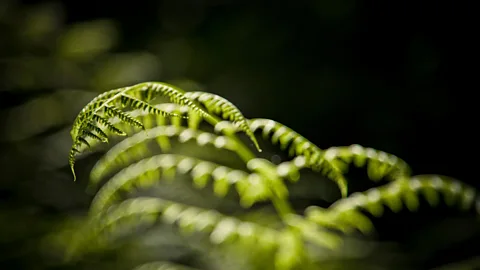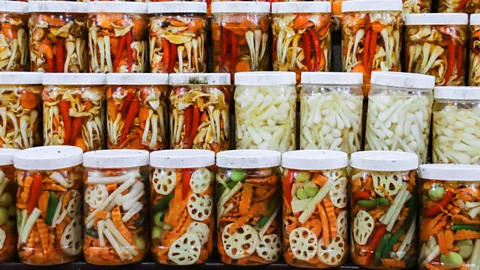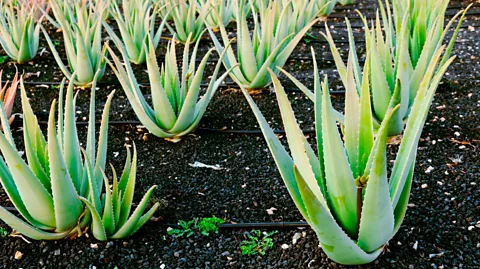Aspartame: What else is 'possibly carcinogenic'?
 Alamy
AlamyAspartame is expected to join aloe vera and bracken ferns on the World Health Organization's list as a "possible human carcinogen". But what does it all mean?
They can be found in the most unexpected of places. Nonchalantly unfurling their fronds at the side of a road. Resting innocently on the shelves of a health food store. Languishing among ancient condiments in the fridge. An ambition for a weekend hobby, at the back of your mind.
These are the contents of the World Health Organization's (WHO) watchlist of the dubious and questionable – things they consider to be "possibly carcinogenic to humans", otherwise known as Group 2B. Many of the 94 items on the inventory are perhaps not particularly surprising: gasoline, infection with HIV type 2, working with asphalt. But it also includes a number of seemingly wholesome entities, such as bracken ferns, aloe vera extract and traditional Asian pickled vegetables. Even a spot of carpentry could land you on the wrong side of this register.
In July this year, the WHO is expected to add the artificial sweetener aspartame into the mix. The product has been under scrutiny from the scientific community for decades, though this development is still seen as a bold move. Aspartame can be found in around 6,000 food products globally – and industry bodies have criticised the new categorisation as misleading and confusing. In the past, similar moves have led to lawsuits.
So, what else can be found on the list? How is it compiled? And do all the items have comparable levels of risk?
 Alamy
AlamyA strange assemblage
The WHO's list of possible carcinogens is assembled by its cancer research arm, The International Agency for Research on Cancer (IARC). By combining scientific evidence from human and animal studies with other relevant data, such as possible mechanisms of carcinogenicity, they categorise items of concern into four possible groups.
- Group 1 – carcinogenic to humans. Includes alcohol, certain types of HPV and ionising radiation.
- Group 2A – probably carcinogenic to humans. Includes red meat, working overnight, and outdoor air pollution.
- Group 2B – possibly carcinogenic to humans. Soon to include aspartame.
- Group 3 – not classifiable as to its carcinogenicity to humans (there isn't adequate evidence of carcinogenicity in humans or animals). Includes some kinds of anaesthetic, silicone breast implants and hair dyes.
For Group 2B, it is necessary to have "limited evidence of carcinogenicity in humans and sufficient evidence of carcinogenicity in experimental animals", though there are come caveats. Items could also fall into this category even if there isn't any direct evidence of their cancer-causing properties in humans, as long as there is also strong evidence that the mechanism via which it does this in animals also applies to people.
 Alamy
AlamyFor example, aloe vera was added to Group 2B after a two-year study in rats found that those whose drinking water was spiked with an extract of its leaves had a higher chance of developing cancers of the large intestine. Crucially, other research has shown that certain aloe chemicals are converted into those that may be damaging to DNA – and therefore possibly able to cause cancer – in the guts of both rats and humans. So, there's evidence of possible carcinogenicity in animals and a reason this could theoretically happen in people.
Alongside ferns and pickled vegetables, some of the more remarkable items in Group 2B include progesterone-only contraceptives, radiofrequency magnetic fields – which are emitted by many common electronic devices, including mobile phones – and naphthalene – the main ingredient of moth balls. The list also implicates a number of plant isolates, such as kava extract, used for centuries in the South Pacific Islands as a ceremonial drink with intoxicating properties, as well as Ginkgo biloba extract and goldenseal root powder, which are sold as herbal medicines.
Finally, there are also a number of professions and activities in Group 2B: in addition to carpentry, joinery and working with bitumen, the WHO categorises the dry cleaning and textile manufacturing industries as possibly carcinogenic to humans.
 Alamy
AlamyA possible risk
But, though these miscellaneous items all fall into the same WHO carcinogenicity group, there is no suggestion that, say, inhaling asphalt fumes all day while you work is as risky as eating a plateful of blanched and buttered fronds of bracken fern – a popular delicacy with foragers in many parts of the world, including the US.
The WHO guidelines do not quantify the risk of any Group 2B substances, nor do they recommend limits for your exposure. Instead, the category simply indicates how strong the evidence is that they have some carcinogenic effects (Read more from the BBC about whether aspartame is a possible cause of cancer.)
So, people may still be able to enjoy the occasional sweetened soft drink with a plate of Asian pickled vegetables – within reasonable limits. According to the US Food and Drug Administration, the acceptable recommended intake for aspartame is up to 50mg per kg of body weight each day, equivalent to the amount in around 19 standard-sized cans of Diet Coke (other brands are available) for the average American woman.
That is, as long as they are comfortable with the knowledge that they may – according to the WHO – be taking a risk.
--
